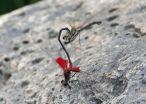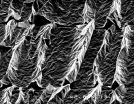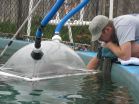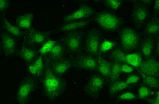(Press-News.org) Why do animals fight with members of other species? A nine-year study by UCLA biologists says the reason often has to do with "obtaining priority access to females" in the area.
The scientists observed and analyzed the behavior of several species of Hetaerina damselflies, also known as rubyspot damselflies. For the study, published this month in the print edition of the journal Proceedings of the Royal Society B, researchers observed more than 100 damselflies a day in their natural habitat along rivers and streams in Texas, Arizona and Mexico.
Male damselflies always respond aggressively to males of their own species that fly into their territory. Males typically ignore males of another damselfly species when they do not compete for females, but respond aggressively to males of another species that invade their territory and attempt to mate with females.
Female damselflies almost always refuse to mate with males of a different species, said Gregory Grether, a UCLA professor of ecology and evolutionary biology and senior author of the study. But that doesn't stop some males from trying, especially in cases where the females of both species have similar coloration.
"We were surprised to see how well the degree of reproductive interference -- the competition for mates between species -- predicts the degree of aggression between species," said Jonathan Drury, who was lead author of the study and is now a postdoctoral researcher at the École Normale Supérieure in Paris.
Grether and Kenichi Okamoto, a postdoctoral scholar at North Carolina State University, developed a mathematical model predicting that as competition for mates increases, male aggression increases, and showing at what point aggression against another species becomes advantageous. Grether and Drury tested and confirmed their model with help from Christopher Anderson, an assistant professor of biological sciences at Dominican University. (Drury and Anderson were all previously doctoral students in Grether's laboratory.)
It's common to find two species of damselflies in one location. The biologists documented some cases where aggression between species has essentially disappeared because of substantial divergence in wing coloration. However, in most of the pairs of species they studied, there is very little difference in color, and males are as aggressive to males of another species as to males of their own species.
"Male damselflies often have difficulty distinguishing between females of their own species and another species when making split-second decisions about whether to pursue a female," Grether said. "I think that's the root cause of the persistence of male territorial aggression."
The researchers sectioned off a part of the river, marked the damselflies for identification, and observed and analyzed rates of fighting within and between species. Territorial battles between two males can last a few hours, the biologists found.
Damselflies typically live only a couple of weeks, and have few mating opportunities.
"Low levels of reproductive interference are associated with low levels of aggression, and high levels of reproductive interference are associated with high levels of aggression," Grether said.
The researchers also conducted experiments in which they captured damselflies and flew them, tethered with a transparent thread, into the nearby territories of other damselflies in order to measure the responses.
A male damselfly often rammed into a tethered male intruder of the same species more than 100 times in two minutes, they found, while blithely ignoring a tethered male of a species that differed substantially in wing coloration.
Grether believes the findings about territorial aggression are likely to hold true with other species that have mating territories, including reptiles, amphibians, insects and some species of birds. He wants to extend the research to species that are in competition for resources besides mates, such as birds, which compete for food and nesting sites.
Implications for humans
As for humans, Grether thinks reproductive interference and aggression between species may well have played an important role in our evolutionary past. Modern humans have existed for at least 200,000 years, he noted, and Neanderthals did not disappear until approximately 40,000 years ago.
"There is genetic evidence of interbreeding between the two species," Grether said. "Interbreeding and warfare with modern humans are usually viewed as completely different explanations for the demise of the Neanderthals, but they might not be different explanations after all. Fighting between Homo sapiens and Homo neanderthalensis groups might well have been motivated in part by inter-mating, just as it is in some cases of warfare between traditional human groups."
Interspecies aggression and its evolutionary impact are understudied subjects, Grether said.
INFORMATION:
The research is funded by the National Science Foundation (grant DEB-1020586).
As the world's exponentially growing demand for digital data slows the Internet and cell phone communication, City College of New York researchers may have just figured out a new way to increase its speed.
Giovanni Milione, a PhD student under City College Distinguished Professor of Science and Engineering Robert Alfano, led the pioneering experiment conducted at the University of Southern California with collaborators from Corning Incorporated, Scotland, Italy and Canada.
"Conventional methods of data transmission use light which has the fastest speed in the universe. ...
Polymer science will have to add a new giant molecule to its lexicon thanks to a cutting-edge discovery at The University of Akron. Taking a revolutionary "building blocks" approach, researchers have pioneered a way to create a new class of very large polymer molecules, called macromolecules, which assemble themselves into strong, stable structures. The work has been done in collaboration with researchers at Peking University in China and The University of Tokyo in Japan. Their findings have been published in the April 24, 2015 issue of Science magazine.
A team led by ...
We know of about two dozen runaway stars, and have even found one runaway star cluster escaping its galaxy forever. Now, astronomers have spotted 11 runaway galaxies that have been flung out of their homes to wander the void of intergalactic space.
"These galaxies are facing a lonely future, exiled from the galaxy clusters they used to live in," said astronomer Igor Chilingarian (Harvard-Smithsonian Center for Astrophysics/Moscow State University). Chilingarian is the lead author of the study, which is appearing in the journal Science.
An object is a runaway if it's ...
You think that your immune system is there to protect you. But what happens when it starts working against you?
In the earliest stages of cancer formation, the immune system is forced to make a momentous decision. It either activates and suppresses tumor growth to help the body fight disease, or it becomes dysfunctional, helping the tumor grow and making treatment more difficult. Because this tipping point occurs before a person even realizes something is wrong, doctors are unable to directly observe this critical stage.
"We believe that when immune cells enter a tumor ...
WORCESTER, MA - Scientists at the University of Massachusetts Medical School have applied a powerful tool in a new way to characterize genetic variants associated with human disease. The work, published today in Cell, will allow scientists to more easily and efficiently describe genomic variations underlying complex, multi-gene diseases.
"Up to this point, we've only been able to investigate one disease-causing mutation at a time," said principal investigator Marian Walhout, PhD, co-director of the Program in Systems Biology and professor of molecular medicine at UMMS. ...
The oncologists Manuel Hidalgo, Director of the Clinical Research Programme of the Spanish National Cancer Research Centre (CNIO), and Ignacio Garrido-Laguna, member of the Experimental Therapeutics Program at Huntsman Cancer Institute of the University of Utah (USA), have recently published a review of state-of-the-art clinical treatments for pancreatic cancer -- including the most current therapies and innovative research -- in the prestigious scientific journal Nature Reviews Clinical Oncology.
In their study, which reviews around 200 scientific articles published ...
PROVIDENCE, R.I. [Brown University] -- Using a technique that introduces tiny wrinkles into sheets of graphene, researchers from Brown University have developed new textured surfaces for culturing cells in the lab that better mimic the complex surroundings in which cells grow in the body.
"We know that cells are shaped by their surroundings," said Ian Y. Wong, assistant professor of engineering and one of the study's authors. "We've shown that you can make textured environments for cell culture fairly easily using graphene."
Traditionally, cell culture in the lab has ...
An enzyme secreted by the body's fat tissue controls energy levels in the brain, according to new research at Washington University School of Medicine in St. Louis. The findings, in mice, underscore a role for the body's fat tissue in controlling the brain's response to food scarcity, and suggest there is an optimal amount of body fat for maximizing health and longevity.
The study appears April 23 in the journal Cell Metabolism.
"We showed that fat tissue controls brain function in a really interesting way," said senior author Shin-ichiro Imai, MD, PhD, professor of ...
Dolphins that raise their voices to be heard in noisy environments expend extra energy in doing so, according to new research that for the first time measures the biological costs to marine mammals of trying to communicate over the sounds of ship traffic or other sources.
While dolphins expend only slightly more energy on louder whistles or other vocalizations, the metabolic cost may add up over time when the animals must compensate for chronic background noise, according to the research by scientists at NOAA Fisheries' Northwest Fisheries Science Center and the University ...
TORONTO, ON. (23 April, 2015) - A new study led by University of Toronto researcher Dr. David Lam has discovered the trigger behind the most severe forms of cancer pain. Released in top journal Pain this month, the study points to TMPRSS2 as the culprit: a gene that is also responsible for some of the most aggressive forms of androgen-fuelled cancers.
Head of Oral and Maxillofacial Surgery at the Faculty of Dentistry, Lam's research initially focused on cancers of the head and neck, which affect more than 550,000 people worldwide each year. Studies have shown that these ...




